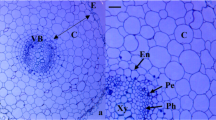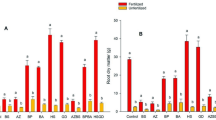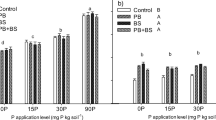Abstract
Inoculants are of great importance in sustainable and/or organic agriculture. In the present study, plant growth of barley (Hordeum vulgare) has been studied in sterile soil inoculated with four plant growth-promoting bacteria and mineral fertilizers at three different soil bulk densities and in three harvests of plants. Three bacterial species were isolated from the rhizosphere of barley and wheat. These bacteria fixed N2, dissolved P and significantly increased growth of barley seedlings. Available phosphate in soil was significantly increased by seed inoculation of Bacillus M-13 and Bacillus RC01. Total culturable bacteria, fungi and P-solubilizing bacteria count increased with time. Data suggest that seed inoculation of barley with Bacillus RC01, Bacillus RC02, Bacillus RC03 and Bacillus M-13 increased root weight by 16.7, 12.5, 8.9 and 12.5% as compared to the control (without bacteria inoculation and mineral fertilizers) and shoot weight by 34.7, 34.7, 28.6 and 32.7%, respectively. Bacterial inoculation gave increases of 20.3–25.7% over the control as compared with 18.9 and 35.1% total biomass weight increases by P and NP application. The concentration of N and P in soil was decreased by increasing soil compaction. In contrast to macronutrients, the concentration of Fe, Cu and Mn was lower in plants grown in the loosest soil. Soil compaction induced a limitation in root and shoot growth that was reflected by a decrease in the microbial population and activity. Our results show that bacterial population was stimulated by the decrease in soil bulk density. The results suggest that the N2-fixing and P-solubilizing bacterial strains tested have a potential on plant growth activity of barley.
Similar content being viewed by others
References
Amer GA, Utkheda RS (2000) Development of formulations of biological agents for management of root rot of lettuce and cucumber. Can J Microbiol 46:809–816
AOAC (1990) Official methods of analysis of the Association of Official Analytical Chemists. In: Helrich K (ed) Association of Official Analytical Chemists (AOAC) Inc., vol 1, 15th edn. AOAC, Arlington, VA, USA
Badalucco L, Kuikman PJ (2001) Mineralization and immobilization in the rhizosphere. In: Pinton R, Varanini Z, Nannipieri P (eds) The rhizosphere: biochemistry and organic substances at the soil–plant interface. Marcel Dekker, New York, pp 159–196
Bashan Y (1998) Inoculants of plant growth-promoting bacteria for use in agriculture. Biotechnol Adv 16:729–770
Bashan Y, Holguin G (1998) Proposal for the division of plant growth-promoting rhizobacteria into two classifications: biocontrol-PGPB (plant growth-promoting bacteria) and PGPB. Soil Biol Biochem 30:1225–1228
Bashan Y, Holguin G, de-Bashan LE (2004) Azospirillum-plant relationships: physiological, molecular, agricultural, and environmental advances. Can J Microbiol 50:521–577
Bertrand H, Nalin R, Bally R, Cleyet-Marel JC (2001) Isolation and identification of the most efficient plant growth-promoting bacteria associated with canola (Brassica napus). Biol Fertil Soils 33:152–156
Blake GR, Hartge KH (1986) Bulk density. In: Klute A (ed) Methods of soil analysis. Part 1. ASA-SSSA, Madison, WI, pp 363–375
Carrillo AE, Li CY, Bashan Y (2002) Increased acidification in the rhizosphere of cactus seedlings induced by Azospirillum brasilense. Naturwissenschaften 89:428–432
De Freitas JR, Banerjee MR, Germida JJ (1997) Phosphate-solubilizing rhizobacteria enhance the growth and yield but not phosphorus uptake of canola (Brassica napus L.). Biol Fertil Soils 24:358–364
Deubel A, Gransee A, Merbach W (2000) Transformation of organic rhizodepositions by rhizosphere bacteria and its influence on the availability of tertiary calcium phosphate. J Plant Nutr Soil Sci 163:387–392
Dobbelaere S, Croonenborghs A, Thys A, Ptacek D, Okon Y, Vanderleyden J (2002) Effect of inoculation with wild type Azospirillum brasilense and A. irakense strains on development and nitrogen uptake of spring wheat and grain maize. Biol Fertil Soils 36:284–297
Farrell RE, Walley FL, Lukey AP, Germida JJ (1993) Manual and digital line-intercept methods for measuring root length: a comparison. Agron J 85:1233–1237
Forbes BA, Sahm DF, Weissfeld AS (2002) Bailey and Scott's diagnostic microbiology, 11th edn. Mosby, St. Louis, MO, USA
Glick BR, Bashan Y (1997) Genetic manipulation of plant growth-promoting bacteria to enhance biocontrol of phytopathogens. Biotechnol Adv 15:353–378
Groleau-Renaud V, Plantureux S, Guckert A (1998) Influence of plant morphology on root exudation of maize subjected to mechanical impedance in hydroponic conditions. Plant Soil 201:231–239
Gyaneshwar P, Kumar GN, Parekh LJ (1998) Effect of buffering on the phosphate-solubilizing ability of microorganisms. W J Microbiol Biotechnol 14:669–673
Iyamuremye F, Dick RP (1996) Organic amendments and phosphorus sorption by soils. Adv Agron 56:139–185
Jordan D, Ponder F Jr, Hubbard VC (2003) Effects of soil compaction, forest leaf litter and nitrogen fertilizer on two oak species and microbial activity. Appl Soil Ecol 23:33–41
Kumar V, Narula N (1999) Solubilization of inorganic phosphates and growth emergence of wheat as affected by Azotobacter chroococcum. Biol Fertil Soils 28:301–305
Lucy M, Reed E, Glick BR (2004) Applications of free living plant growth-promoting rhizobacteria. Antonie Van Leeuwenhoek 86:1–25
Martin JP (1950) Use of acid rose Bengal and streptomycin in the plate method for estimating soil fungi. Soil Sci 69:215–232
Mehta S, Nautiyal CS (2001) An efficient method for qualitative screening of phosphate-solubilizing bacteria. Curr Microbiol 43:51–56
Nautiyal CS, Bhadauria S, Kumar P, Lal H, Mondal R, Verma D (2000) Stress induced phosphate solubilization in bacteria isolated from alkaline soils. FEMS Microbiol Lett 182:291–296
Oliveira ALM, Urquiaga S, Döbereiner J, Baldani JI (2002) The effect of inoculating endophytic N2-fixing bacteria on micropropagated sugarcane plants. Plant Soil 242:205–215
Olsen SR, Sommers LE (1982) Phosphorus. In: Page AL, Miller RH, Keeney DR (eds) Methods of soil analysis part 2. ASA-SSSA, Madison, WI, pp 403–427
Oussible M, Crookston PK, Larson WE (1992) Subsurface compaction reduces the root and shoot growth and grain yield of wheat. Agron J 84:34–38
Pal SS (1998) Interactions of an acid tolerant strain of phosphate solubilizing bacteria with a few acid tolerant crops. Plant Soil 198:169–177
Pikovskaya RE (1948) Mobilization of phosphates in soil in connection with vital activities of some microbial species. Mikrobiologia 17:362–370
Puente ME, Bashan Y, Li CY, Lebsky VK (2004a) Microbial populations and activities in the rhizoplane of rock-weathering desert plants. I. Root colonization and weathering of igneous rocks. Plant Biol 6:629–642
Puente ME, Li CY, Bashan Y (2004b) Microbial populations and activities in the rhizoplane of rock-weathering desert plants. II. Growth promotion of cactus seedlings. Plant Biol 6:643–650
Rodriguez H, Fraga R (1999) Phosphate solubilizing bacteria and their role in plant growth promotion. Biotechnol Adv 17:319–339
Rodriguez H, Gonzalez T, Goire I, Bashan Y (2004) Gluconic acid production and phosphate solubilization by the plant growth-promoting bacterium Azospirillum spp. Naturwissenschaften 91:552–555
Rojas A, Holguin G, Glick BR, Bashan Y (2001) Synergism between Phyllobacterium sp. (N2-fixer) and Bacillus licheniformis (P-solubilizer), both from a semiarid mangrove rhizosphere. FEMS Microbiol Ecol 35:181–187
Şahin F, Çakmakçı R, Kantar F (2004) Sugar beet and barley yields in relation to inoculation with N2-fixing and phosphate solubilizing bacteria. Plant Soil 265:123–129
Salle AJ (1973) Laboratory manual on fundamental principles of bacteriology. McGraw-Hill, New York, USA
Shishido M, Chanway CP (1998) Forest soil community responses to plant growth-promoting rhizobacteria and spruce seedlings. Biol Fertil Soils 26:179–186
Soil Survey Staff (1999) Soil taxonomy: a basic system of soil classification for making and interpreting soil surveys, 2nd edn. USDA-SCS Agriculture Handbook 436. US Government Printing Office, Washington, DC
Steenhoudt O, Vanderleyden J (2000) Azospirillum, a free-living nitrogen-fixing bacterium closely associated with grasses: genetic, biochemical and ecological aspects. FEMS Microbiol Rev 24:487–506
Sundara B, Natarajan V, Hari K (2002) Influence of phosphorus solubilizing bacteria on the changes in soil available phosphorus and sugarcane and sugar yield. Field Crops Res 77:43–49
Vivas A, Marulanda A, Ruiz-Lozano JM, Barea JM, Azcon R (2003) Influence of a Bacillus sp on physiological activities of two arbuscular mycorrhizal fungi and plant responses to PEG-induced drought stress. Mycorrhiza 13:249–256
Welbaum GE, Sturz, AV, Dong ZM, Nowak J (2004) Managing soil microorganisms to improve productivity of agro-ecosystems. Crit Rev Plant Sci 23:175–193
Yadav KS, Dadarwal KR (1997) Phosphate solubilization and mobilization through soil microorganisms. In: Dadarwal KR (ed) Biotechnological approaches in soil microorganisms for sustainable crop production. Scientific, Jodhpur, India, pp 293–308
Acknowledgements
This study was supported by The Turkish Academy of Sciences- TUBA- GEBIP programme.
Author information
Authors and Affiliations
Corresponding author
Rights and permissions
About this article
Cite this article
Canbolat, M.Y., Bilen, S., Çakmakçı, R. et al. Effect of plant growth-promoting bacteria and soil compaction on barley seedling growth, nutrient uptake, soil properties and rhizosphere microflora. Biol Fertil Soils 42, 350–357 (2006). https://doi.org/10.1007/s00374-005-0034-9
Received:
Revised:
Accepted:
Published:
Issue Date:
DOI: https://doi.org/10.1007/s00374-005-0034-9




